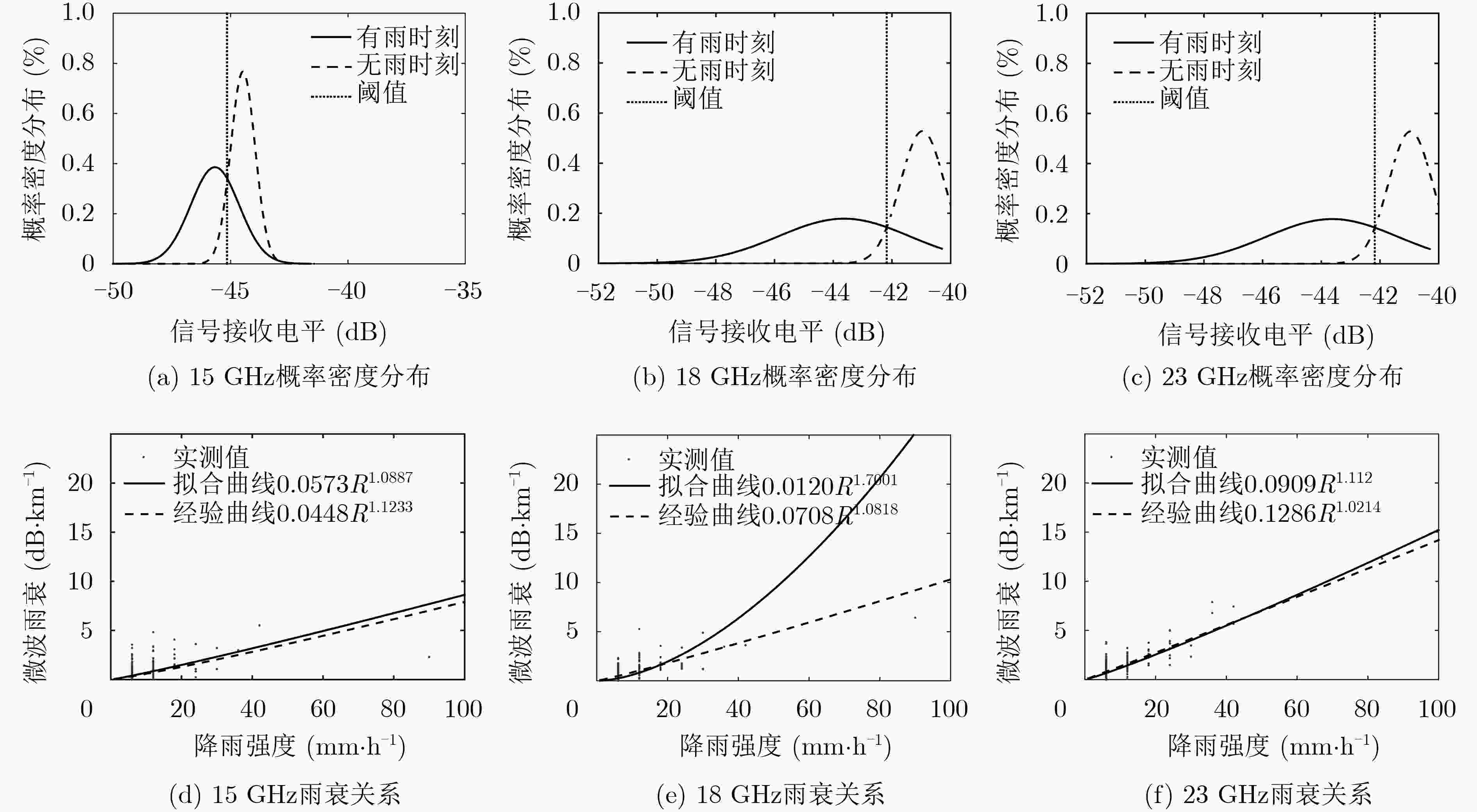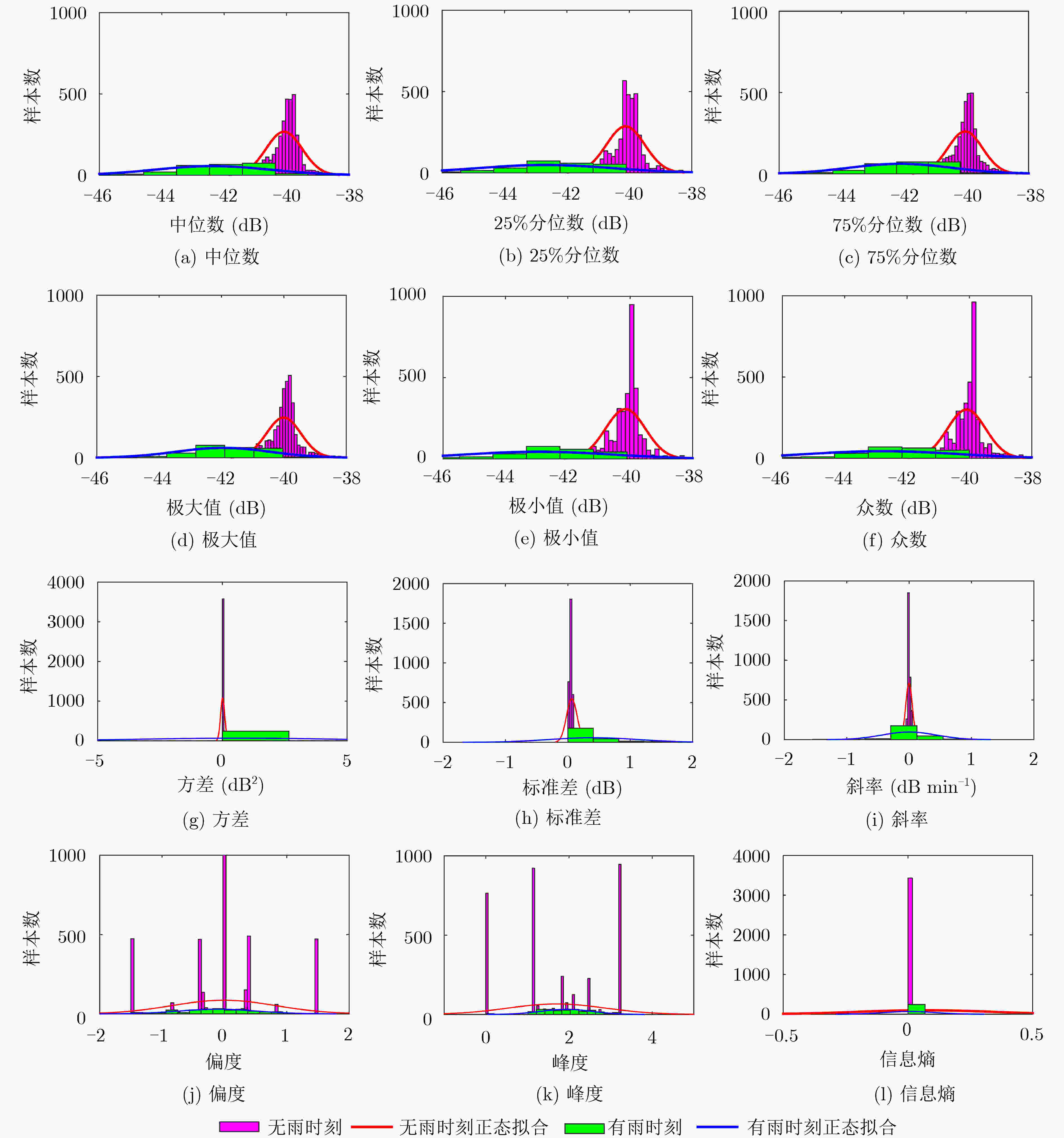Analysis of Sensitive Parameters of 15~23 GHz Microwave Link Induced by Rain Attenuation
-
摘要: 为了提高微波链路雨衰特征的描述精度,拓展微波链路信号的可用参数,该文利用部署于江苏江阴地区的15 GHz, 18 GHz和23 GHz微波链路和雨量计开展同步对比观测,拟合得到3种频段的微波链路雨衰关系。提取并分析了接收信号电平的平均值、中位数、25%分位数、75%分位数、标准差、极大值和极小值等13个特征量与晴雨时刻、降雨强度之间的关系,得出结论:微波链路的信号变化和降雨强度的变化存在明显的负相关关系。实际拟合的雨衰关系与ITU-R的经验雨衰关系具有较好的一致性,但是在不同频段上均有差异;所有13个参量在有雨时刻和无雨时刻均存在一定概率的重叠,这是造成晴雨区分困难的主要原因;频率越高,信号变化受降雨的影响越显著,越有利于微波链路反演降雨。所得出的结论为提高微波链路测雨方法中的晴雨区分、参考值确定以及雨强反演的精度提供重要依据。Abstract: To improve the description accuracy of the characteristics of microwave link induced by rain attenuation and expand the available parameters of microwave link signals, the 15 GHz, 18 GHz and 23 GHz microwave links and rain gauges deployed in Jiangyin area of Jiangsu Province are used to carry out synchronous comparative observation, and the rain attenuation relationship at three frequency bands are fitted. The relationship between the 13 features of the received signal level (including the average, median, 25% quantile, 75% quantile, standard deviation, maximum, minimum, etc.) and the rain/no-rain period and rainfall intensity is extracted and analyzed. The conclusions are as follows. There is an obvious negative correlation between the signal of microwave link and the rainfall intensity. There is a general good consistency between the fitted rain attenuation relationship and the ITU-R empirical rain attenuation relationship, but there are certain of differences in different frequencies; All 13 parameters have a certain probability of overlap in the rain period and no-rain period, which is the main reason why it is difficult to distinguish between rain and no-rain; The higher is the frequency, the more significant is the impact of rainfall on the signal change, the more conducive to the microwave link inversion of rainfall. The results provide an important basis for improving the discrimination of rain and no-rain, and determination of reference value and inversion of rain intensity.
-
Key words:
- Microwave link /
- Rainfall /
- Rain attenuation relationship /
- Features
-
表 1 微波信号特征量
序号 特征量 公式 序号 特征量 公式 1 中位数 ${m_{0.5}} = {X_{(N + 1)/2}}$ 7 方差 ${S^2} = \dfrac{1}{N}\displaystyle\sum\limits_{i = 1}^N {{{({X_i} - \bar X)}^2}} $ 2 25%分位数 ${m_{0.25}} = {X_{(N + 1)/2}}$ 8 标准差 $\sigma = \sqrt {\dfrac{1}{N}\displaystyle\sum\limits_{i = 1}^N {{{({X_i} - \bar X)}^2}} } $ 3 75%分位数 ${m_{0.75}} = {X_{(N + 1)/2}}$ 9 斜率 $Sl = \dfrac{{\left( {\displaystyle\sum {t_i^2} } \right)\left( {\displaystyle\sum {{X_i}} } \right) - \left( {\displaystyle\sum {{t_i}} } \right)\left( {\displaystyle\sum {{t_i}{X_i}} } \right)}}{{N\left( {\displaystyle\sum {t_i^2} } \right) - {{\left( {\displaystyle\sum {{t_i}} } \right)}^2}}}$ 4 极大值 ${X_{\max } } = \max ({X_1}\; {X_2}\; ··· \;{X_N})$ 10 偏度 $Sk = \dfrac{{\dfrac{1}{N}\displaystyle\sum\limits_{i = 1}^N {{{({X_i} - \bar X)}^3}} }}{{{{\left( {\dfrac{1}{N}\displaystyle\sum\limits_{i = 1}^N {{{({X_i} - \bar X)}^2}} } \right)}^{\dfrac{3}{2}}}}}$ 5 极小值 ${X_{\min } } = \min ({X_1}\; {X_2} \;··· \; {X_N})$ 11 峰度 $Ku = \dfrac{{\dfrac{1}{N}\displaystyle\sum\limits_{i = 1}^N {{{({X_i} - \bar X)}^4}} }}{{{{\left( {\dfrac{1}{N}\displaystyle\sum\limits_{i = 1}^N {{{({X_i} - \bar X)}^2}} } \right)}^2}}}$ 6 众数 ${X_{mo}} = L + \dfrac{{{f_b}}}{{{f_a} + {f_b}}} \cdot i$ 12 信息熵 $HU = - \displaystyle\sum\limits_{i = 1}^N {P({X_i}){{\log }_2}P({X_i})} $ 表 2 微波链路信号特征量与雨强的相关系数
序号 特征量 与雨强的相关系数(%) 15 GHz 18 GHz 23 GHz 1 平均值 –42.84 –69.52 –82.36 2 中位数 –41.83 –70.58 –81.58 3 25%分位数 –44.24 –70.14 –81.52 4 75%分位数 –38.38 –60.76 –77.61 5 极大值 –34.52 –52.82 –75.38 6 极小值 –46.37 –70.48 –77.50 7 众数 –44.35 –70.78 –77.08 8 方差 31.58 46.66 27.40 9 标准差 39.88 58.46 43.86 10 斜率 12.68 41.41 10.62 11 偏度 2.99 3.35 8.37 12 峰度 5.52 0.66 0.75 13 信息熵 9.14 3.43 4.23 -
[1] 孙学金, 王晓蕾, 李浩, 等. 大气探测学[M]. 北京: 气象出版社, 2009: 452.SUN Xuejin, WANG Xiaolei, LI Hao, et al. Atmospheric Sounding[M]. Beijing: China Meteorological Press, 2009: 452. [2] 李海, 任嘉伟, 尚金雷. 一种基于模糊神经网络–模糊C均值聚类的双偏振气象雷达降水粒子分类方法[J]. 电子与信息学报, 2019, 41(4): 809–815. doi: 10.11999/JEIT180529LI Hai, REN Jiawei, and SHANG Jinlei. Hydrometeor classification method in dual-polarization weather radar based on fuzzy neural network-fuzzy C-means[J]. Journal of Electronics &Information Technology, 2019, 41(4): 809–815. doi: 10.11999/JEIT180529 [3] 刘西川, 高太长, 刘磊, 等. 雨滴微物理特征研究及测量技术进展[J]. 地球科学进展, 2013, 28(11): 1217–1226. doi: 10.11867/j.issn.1001-8166.2013.11.1217LIU Xichuan, GAO Taichang, LIU Lei, et al. Advances in microphysical features and measurement techniques of raindrops[J]. Advances in Earth Science, 2013, 28(11): 1217–1226. doi: 10.11867/j.issn.1001-8166.2013.11.1217 [4] 卢海梁, 王志强, 高超, 等. 基于被动干涉微波亮温图像的海面目标探测算法研究[J]. 电子与信息学报, 2020, 42(3): 563–572. doi: 10.11999/JEIT190256LU Hailiang, WANG Zhiqiang, GAO Chao, et al. Research on the detection algorithm for sea surface targets based on passive interferometric microwave images[J]. Journal of Electronics &Information Technology, 2020, 42(3): 563–572. doi: 10.11999/JEIT190256 [5] MESSER H, ZINEVICH A, and ALPERT P. Environmental monitoring by wireless communication networks[J]. Science, 2006, 312(5774): 713. doi: 10.1126/science.1120034 [6] 印敏, 高太长, 刘西川, 等. 微波链路测量降水研究综述[J]. 气象, 2015, 41(12): 1545–1553. doi: 10.7519/j.issn.1000-0526.2015.12.013YIN Min, GAO Taichang, LIU Xichuan, et al. Research on microwave link measurement of precipitation[J]. Meteorological Monthly, 2015, 41(12): 1545–1553. doi: 10.7519/j.issn.1000-0526.2015.12.013 [7] 刘西川, 宋堃, 高太长, 等. 复杂大气条件对微波传播衰减的影响研究[J]. 电子与信息学报, 2018, 40(1): 181–188. doi: 10.11999/JEIT170253LIU Xichuan, SONG Kun, GAO Taichang, et al. Research on the effect of complex atmospheric condition on microwave propagation attenuation[J]. Journal of Electronics &Information Technology, 2018, 40(1): 181–188. doi: 10.11999/JEIT170253 [8] CHWALA C and KUNSTMANN H. Commercial microwave link networks for rainfall observation: Assessment of the current status and future challenges[J]. WIREs Water, 2019, 6(2): e1337. doi: 10.1002/wat2.1337 [9] 刘西川, 高太长, 秦健, 等. 降雨对微波传输特性的影响分析[J]. 物理学报, 2010, 59(3): 2156–2162. doi: 10.7498/aps.59.2156LIU Xichuan, GAO Taichang, QIN Jian, et al. Effects analysis of rainfall on microwave transmission characteristics[J]. Acta Physica Sinica, 2010, 59(3): 2156–2162. doi: 10.7498/aps.59.2156 [10] ITU. Specific attenuation model for rain for use in prediction methods[R]. ITU-R P. 838–3, 2005. [11] SHARMA P K, SHARMA D, and SINGH R K. Development of propagation model by considering different climatic conditions[J]. MAGNT Research Report, 2014, 2(6): 389–401. [12] 赵振维, 卢昌胜, 林乐科. 基于雨胞分布的视距链路雨衰减预报模型[J]. 电波科学学报, 2009, 24(4): 627–631. doi: 10.13443/j.cjors.2009.04.014ZHAO Zhenwei, LU Changsheng, and LIN Leke. Prediction model of rain attenuation based on the EXCELL rain cell model for the terrestrial line-of-sight systems[J]. Chinese Journal of Radio Science, 2009, 24(4): 627–631. doi: 10.13443/j.cjors.2009.04.014 [13] 宋博, 王红星, 刘敏, 等. 雨滴谱模型对雨衰减计算的适用性分析[J]. 激光与红外, 2012, 42(3): 310–313. doi: 10.3969/j.issn.1001-5078.2012.03.015SONG Bo, WANG Hongxing, LIU Min, et al. Raindrop size distribution model for applicability analysis of rain attenuation[J]. Laser &Infrared, 2012, 42(3): 310–313. doi: 10.3969/j.issn.1001-5078.2012.03.015 [14] ITU. Propagation data and prediction methods required for the design of earth-space telecommunication systems[R]. ITU-R P. 618–1, 1996. [15] 杨瑞科. 对流层地—空路径电磁(光)波传播的若干问题研究[D]. [博士论文], 西安电子科技大学, 2003: 1–150.YANG Ruike. Research on several electromagnetic (optical) wave propagation problems on Earth-space path in troposphere atmosphere[D]. [Ph. D. dissertation], Xidian University, 2003: 1–150. [16] 申弢, 黄树红, 韩守木, 等. 旋转机械振动信号的信息熵特征[J]. 机械工程学报, 2001, 37(6): 94–98. doi: 10.3321/j.issn:0577-6686.2001.06.021SHEN Tao, HUANG Shuhong, HAN Shoumu, et al. Extracting information entropy features for rotating machinery vibration signals[J]. Journal of Mechanical Engineering, 2001, 37(6): 94–98. doi: 10.3321/j.issn:0577-6686.2001.06.021 -






 下载:
下载:





 下载:
下载:
